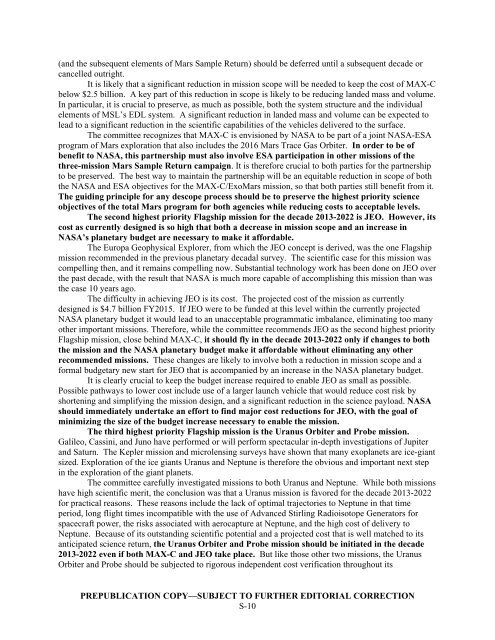Vision and Voyages for Planetary Science in the - Solar System ...
Vision and Voyages for Planetary Science in the - Solar System ...
Vision and Voyages for Planetary Science in the - Solar System ...
You also want an ePaper? Increase the reach of your titles
YUMPU automatically turns print PDFs into web optimized ePapers that Google loves.
(<strong>and</strong> <strong>the</strong> subsequent elements of Mars Sample Return) should be deferred until a subsequent decade or<br />
cancelled outright.<br />
It is likely that a significant reduction <strong>in</strong> mission scope will be needed to keep <strong>the</strong> cost of MAX-C<br />
below $2.5 billion. A key part of this reduction <strong>in</strong> scope is likely to be reduc<strong>in</strong>g l<strong>and</strong>ed mass <strong>and</strong> volume.<br />
In particular, it is crucial to preserve, as much as possible, both <strong>the</strong> system structure <strong>and</strong> <strong>the</strong> <strong>in</strong>dividual<br />
elements of MSL’s EDL system. A significant reduction <strong>in</strong> l<strong>and</strong>ed mass <strong>and</strong> volume can be expected to<br />
lead to a significant reduction <strong>in</strong> <strong>the</strong> scientific capabilities of <strong>the</strong> vehicles delivered to <strong>the</strong> surface.<br />
The committee recognizes that MAX-C is envisioned by NASA to be part of a jo<strong>in</strong>t NASA-ESA<br />
program of Mars exploration that also <strong>in</strong>cludes <strong>the</strong> 2016 Mars Trace Gas Orbiter. In order to be of<br />
benefit to NASA, this partnership must also <strong>in</strong>volve ESA participation <strong>in</strong> o<strong>the</strong>r missions of <strong>the</strong><br />
three-mission Mars Sample Return campaign. It is <strong>the</strong>re<strong>for</strong>e crucial to both parties <strong>for</strong> <strong>the</strong> partnership<br />
to be preserved. The best way to ma<strong>in</strong>ta<strong>in</strong> <strong>the</strong> partnership will be an equitable reduction <strong>in</strong> scope of both<br />
<strong>the</strong> NASA <strong>and</strong> ESA objectives <strong>for</strong> <strong>the</strong> MAX-C/ExoMars mission, so that both parties still benefit from it.<br />
The guid<strong>in</strong>g pr<strong>in</strong>ciple <strong>for</strong> any descope process should be to preserve <strong>the</strong> highest priority science<br />
objectives of <strong>the</strong> total Mars program <strong>for</strong> both agencies while reduc<strong>in</strong>g costs to acceptable levels.<br />
The second highest priority Flagship mission <strong>for</strong> <strong>the</strong> decade 2013-2022 is JEO. However, its<br />
cost as currently designed is so high that both a decrease <strong>in</strong> mission scope <strong>and</strong> an <strong>in</strong>crease <strong>in</strong><br />
NASA’s planetary budget are necessary to make it af<strong>for</strong>dable.<br />
The Europa Geophysical Explorer, from which <strong>the</strong> JEO concept is derived, was <strong>the</strong> one Flagship<br />
mission recommended <strong>in</strong> <strong>the</strong> previous planetary decadal survey. The scientific case <strong>for</strong> this mission was<br />
compell<strong>in</strong>g <strong>the</strong>n, <strong>and</strong> it rema<strong>in</strong>s compell<strong>in</strong>g now. Substantial technology work has been done on JEO over<br />
<strong>the</strong> past decade, with <strong>the</strong> result that NASA is much more capable of accomplish<strong>in</strong>g this mission than was<br />
<strong>the</strong> case 10 years ago.<br />
The difficulty <strong>in</strong> achiev<strong>in</strong>g JEO is its cost. The projected cost of <strong>the</strong> mission as currently<br />
designed is $4.7 billion FY2015. If JEO were to be funded at this level with<strong>in</strong> <strong>the</strong> currently projected<br />
NASA planetary budget it would lead to an unacceptable programmatic imbalance, elim<strong>in</strong>at<strong>in</strong>g too many<br />
o<strong>the</strong>r important missions. There<strong>for</strong>e, while <strong>the</strong> committee recommends JEO as <strong>the</strong> second highest priority<br />
Flagship mission, close beh<strong>in</strong>d MAX-C, it should fly <strong>in</strong> <strong>the</strong> decade 2013-2022 only if changes to both<br />
<strong>the</strong> mission <strong>and</strong> <strong>the</strong> NASA planetary budget make it af<strong>for</strong>dable without elim<strong>in</strong>at<strong>in</strong>g any o<strong>the</strong>r<br />
recommended missions. These changes are likely to <strong>in</strong>volve both a reduction <strong>in</strong> mission scope <strong>and</strong> a<br />
<strong>for</strong>mal budgetary new start <strong>for</strong> JEO that is accompanied by an <strong>in</strong>crease <strong>in</strong> <strong>the</strong> NASA planetary budget.<br />
It is clearly crucial to keep <strong>the</strong> budget <strong>in</strong>crease required to enable JEO as small as possible.<br />
Possible pathways to lower cost <strong>in</strong>clude use of a larger launch vehicle that would reduce cost risk by<br />
shorten<strong>in</strong>g <strong>and</strong> simplify<strong>in</strong>g <strong>the</strong> mission design, <strong>and</strong> a significant reduction <strong>in</strong> <strong>the</strong> science payload. NASA<br />
should immediately undertake an ef<strong>for</strong>t to f<strong>in</strong>d major cost reductions <strong>for</strong> JEO, with <strong>the</strong> goal of<br />
m<strong>in</strong>imiz<strong>in</strong>g <strong>the</strong> size of <strong>the</strong> budget <strong>in</strong>crease necessary to enable <strong>the</strong> mission.<br />
The third highest priority Flagship mission is <strong>the</strong> Uranus Orbiter <strong>and</strong> Probe mission.<br />
Galileo, Cass<strong>in</strong>i, <strong>and</strong> Juno have per<strong>for</strong>med or will per<strong>for</strong>m spectacular <strong>in</strong>-depth <strong>in</strong>vestigations of Jupiter<br />
<strong>and</strong> Saturn. The Kepler mission <strong>and</strong> microlens<strong>in</strong>g surveys have shown that many exoplanets are ice-giant<br />
sized. Exploration of <strong>the</strong> ice giants Uranus <strong>and</strong> Neptune is <strong>the</strong>re<strong>for</strong>e <strong>the</strong> obvious <strong>and</strong> important next step<br />
<strong>in</strong> <strong>the</strong> exploration of <strong>the</strong> giant planets.<br />
The committee carefully <strong>in</strong>vestigated missions to both Uranus <strong>and</strong> Neptune. While both missions<br />
have high scientific merit, <strong>the</strong> conclusion was that a Uranus mission is favored <strong>for</strong> <strong>the</strong> decade 2013-2022<br />
<strong>for</strong> practical reasons. These reasons <strong>in</strong>clude <strong>the</strong> lack of optimal trajectories to Neptune <strong>in</strong> that time<br />
period, long flight times <strong>in</strong>compatible with <strong>the</strong> use of Advanced Stirl<strong>in</strong>g Radioisotope Generators <strong>for</strong><br />
spacecraft power, <strong>the</strong> risks associated with aerocapture at Neptune, <strong>and</strong> <strong>the</strong> high cost of delivery to<br />
Neptune. Because of its outst<strong>and</strong><strong>in</strong>g scientific potential <strong>and</strong> a projected cost that is well matched to its<br />
anticipated science return, <strong>the</strong> Uranus Orbiter <strong>and</strong> Probe mission should be <strong>in</strong>itiated <strong>in</strong> <strong>the</strong> decade<br />
2013-2022 even if both MAX-C <strong>and</strong> JEO take place. But like those o<strong>the</strong>r two missions, <strong>the</strong> Uranus<br />
Orbiter <strong>and</strong> Probe should be subjected to rigorous <strong>in</strong>dependent cost verification throughout its<br />
PREPUBLICATION COPY—SUBJECT TO FURTHER EDITORIAL CORRECTION<br />
S-10











